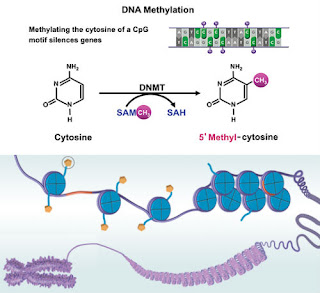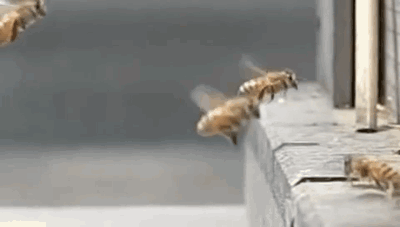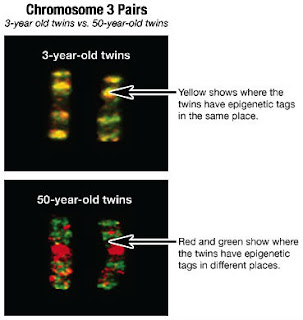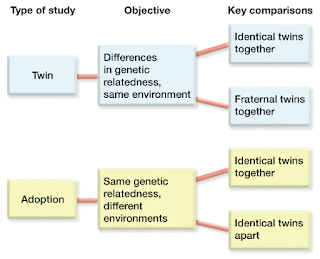Biology concepts – epigenetics, monozygotic twins, mirror image twins
parasitic twins was a bit depressing for me. This week, let’s focus on some amazing kinds of monozygotic (MZ) twins. Yes, there are many kinds of monozygotic twins, some we have talked about (conjoined, parasitic, absorbed, vanished) and some we’ll talk about today. Just because they’re monozygotic doesn’t mean that they only come in one type.
The popular idea is that MZ twins are “identical,” but nothing could be further from the truth. It may not even be the case that they share the same genes, but more about that later. When an embryo splits, each new embryo usually gets the same chromosomes. But a lot can happen after that.
We talked recently about the determination of right and left sides in the embryo by a flow of fluid from left to right (see this post). Well, that same flow can make MZ twins look different. One subtle difference can be their fingerprints. MZ twins don’t have the same fingerprints.
Fingerprints do have a genetic component, so the fingerprints of MZ twins will resemble each other more than non-twin siblings’ will. But the environment of the amniotic sac during gestation, especially during the first trimester, will help to determine the details of the fingerprint. Nutrition level, stress, movement within the sac, even a slight difference in umbilical cord length; these will all result in differences between the prints of MZ twins.
Talk about stress, wartime babies have different fingerprinting patterns than those born in peace, at least the seasonal variations in ridge counts disappear if the gestation is during war. All these things we have been talking about go beyond the foundation of genetics. Traits are established and influenced by genetics, but how they turn out (their phenotype, where pheno = visual form) can influenced by the environment. This is epigenetics (epi = beyond).
The control of gene expression via chemical reactions is the example most often given. The chemical reaction affects the function of a given stretch of DNA, but doesn’t change the sequence of that DNA. The genetics remains intact to be passed on, but which genes are expressed is what changes.
There are two common examples of chemical reactions that affect DNA are methylation and histone acetylation. Let’s look at an example in nature that uses both systems. And it uses a multiple births in the example too – how convenient.
A honey bee colony has a strict structure. There is one queen (usually - of course there are exceptions), a few hundred male drones, and many thousands of female workers. The queen flies out to mate (with 12-24 drones of another colony) during first first two weeks of her life, but then settles down to lay eggs.
If she doesn’t fertilize the egg, it will be a worker, a sterile female clone of herself. If she does fertilize the egg, it will become a male drone. But if she lays a fertilized egg in the large chamber, it becomes a female queen, not a male drone. Why the difference? Their diet.
There is a substance the bees produce called royal jelly. All the larvae are fed royal jelly for the first three days, but after that, only the larva that will become the new queen is fed royal jelly. In fact, that is all the queen will eat her entire life.
The royal jelly is a secretion that comes from the hypopharnyx of the worker bees. It's mostly water, with some protein and amino acids. The active ingredient is called royalactin. It ages and becomes less active over time, so the workers keep making it all the time. Get the subtle point here, the queen lays the eggs, but the workers make the queens.
We also know that queen development is promoted by more histone acetylation. Acetyl groups added to the histone proteins that help coil DNA make it loose and available for transcription (reading the genes that are there). If the histones are deacetylated, the chromatin becomes tight and the machinery can’t get access the genes.
It turns out that royal jelly has a histone deactylase (HDAC) inhibitor. Therefore, more DNA stays acetylated and open to be transcribed. The part that is transcribed might include the demethylase enzyme genes. This leads to less methylation and activation of genes that turn the larva into a queen. So her diet doesn’t change her genes, it just determines which ones will be expressed. And that makes all the difference.
Ask your friends if monozygotic twins are identical and you’ll many more yeses than maybes or nos. But given our discussion above of epigenetics and the power of environment to alter gene expression, do you have any doubt that there are changes that occur afterfertilization and after splitting of the embryo into twins? Epigenetic factors can produce monozygotic twins with different malformations, different lateral asymmetries and even different sexes! (reviewed here)
We talked a few weeks ago about how the embryo distinguishes right from left so that the organs develop in their normal locations. Sometimes they don’t, and this is when we get situs inversus or situs ambiguous. If the split of the embryo that forms MZ twins occurs after the decision has been made as to right-left, then mirror image twins could be a result.
Mirror twins may have moles on their cheeks – one on the right and the other in the same spot, but on the left cheek. They may have mirror hairlines or defects like cleft lip and/or cleft palate. They might even manifest equal but opposite sleep patterns. In most cases, the twins will have some internal organs in mirror locations, but rarely will there be a situs inversus twin and a situs solitus twin. Here’s why.
Most embryonic splits for MZ twins occur in the first 2-10 days, but if the split occurs after day 12 or 13, then some degree of mirror imaging is possible. This is the time when right-left decisions have already been made. Of course, the plane in which the split occurs will matter too, it would have to be directly along the node for a true right-left mirror to occur -there's epigenetics again. This is extremely rare, so most mirror image twins, have some mirror traits, not total mirror bodies.
Even in situs ambiguous (see this post) of MZ twins, there can be mirror imaging of some external and/or internal phenotypes in twins with heterotaxy. Yes, phenotypes – remember that these differences are affected by many things, but not directly genetics. They change the features of the twins while they still have identical genes. It’s epigenetic.
It would be good to know which phenotypes are under strict genetic control and which can be influenced by environment. So while early twins studies concentrated on what was the same between MZ twins, new research is concentrating on what’s discordant (different) between them.
This research will go a long way to showing just how much of our health and life is actually passed down from parents and is inescapable. Even the differences between mirror twins can help to tease out the mechanics of how twinning occurs and the paths and patterns of normal embryology.
Now that we have a handle on epigenetics and its effects on MZ twins, let's talk next week about a couple of twin types that result from genetic differences. Yes, you read that right, some MZ twins are genetically different.
For more information or classroom activities, see:
Epigenetics -






